The Intel Core i9-9900K at 95W: Fixing The Power for SFF
by Ian Cutress on November 29, 2018 8:00 AM ESTCPU Performance: System Tests
Our System Test section focuses significantly on real-world testing, user experience, with a slight nod to throughput. In this section we cover application loading time, image processing, simple scientific physics, emulation, neural simulation, optimized compute, and 3D model development, with a combination of readily available and custom software. For some of these tests, the bigger suites such as PCMark do cover them (we publish those values in our office section), although multiple perspectives is always beneficial. In all our tests we will explain in-depth what is being tested, and how we are testing.
All of our benchmark results can also be found in our benchmark engine, Bench.
Application Load: GIMP 2.10.4
One of the most important aspects about user experience and workflow is how fast does a system respond. A good test of this is to see how long it takes for an application to load. Most applications these days, when on an SSD, load fairly instantly, however some office tools require asset pre-loading before being available. Most operating systems employ caching as well, so when certain software is loaded repeatedly (web browser, office tools), then can be initialized much quicker.
In our last suite, we tested how long it took to load a large PDF in Adobe Acrobat. Unfortunately this test was a nightmare to program for, and didn’t transfer over to Win10 RS3 easily. In the meantime we discovered an application that can automate this test, and we put it up against GIMP, a popular free open-source online photo editing tool, and the major alternative to Adobe Photoshop. We set it to load a large 50MB design template, and perform the load 10 times with 10 seconds in-between each. Due to caching, the first 3-5 results are often slower than the rest, and time to cache can be inconsistent, we take the average of the last five results to show CPU processing on cached loading.
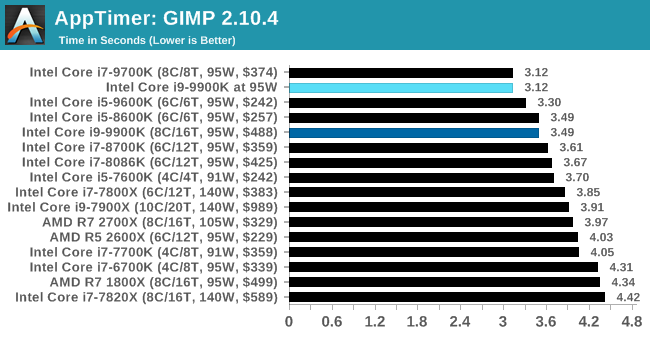
One of the interesting things in these benchmarks is that when in 95W mode, especially in shorter tests, the 9900K actually performs better than the full grunt settings. This could be because the system doesn't have to consider current limits of the power delivery, as 95W is the guaranteed limit no matter the loading.
FCAT: Image Processing
The FCAT software was developed to help detect microstuttering, dropped frames, and run frames in graphics benchmarks when two accelerators were paired together to render a scene. Due to game engines and graphics drivers, not all GPU combinations performed ideally, which led to this software fixing colors to each rendered frame and dynamic raw recording of the data using a video capture device.
The FCAT software takes that recorded video, which in our case is 90 seconds of a 1440p run of Rise of the Tomb Raider, and processes that color data into frame time data so the system can plot an ‘observed’ frame rate, and correlate that to the power consumption of the accelerators. This test, by virtue of how quickly it was put together, is single threaded. We run the process and report the time to completion.
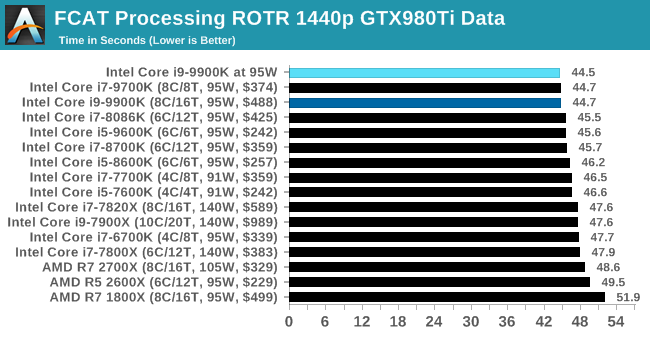
In a slightly longer test, the 9900K @ 95W eeks out the tiniest win.
3D Particle Movement v2.1: Brownian Motion
Our 3DPM test is a custom built benchmark designed to simulate six different particle movement algorithms of points in a 3D space. The algorithms were developed as part of my PhD., and while ultimately perform best on a GPU, provide a good idea on how instruction streams are interpreted by different microarchitectures.
A key part of the algorithms is the random number generation – we use relatively fast generation which ends up implementing dependency chains in the code. The upgrade over the naïve first version of this code solved for false sharing in the caches, a major bottleneck. We are also looking at AVX2 and AVX512 versions of this benchmark for future reviews.
For this test, we run a stock particle set over the six algorithms for 20 seconds apiece, with 10 second pauses, and report the total rate of particle movement, in millions of operations (movements) per second. We have a non-AVX version and an AVX version, with the latter implementing AVX512 and AVX2 where possible.
3DPM v2.1 can be downloaded from our server: 3DPMv2.1.rar (13.0 MB)
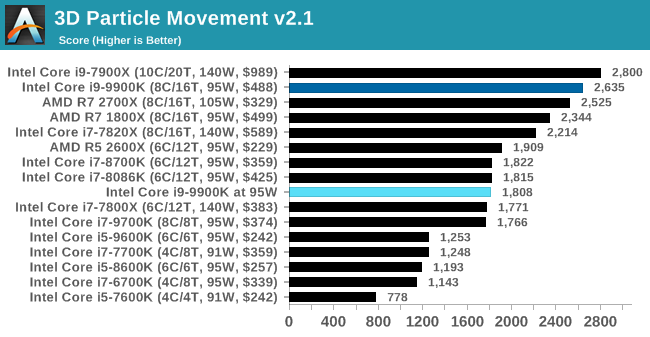
As we move onto something more substantial with all the threads, the 95W setting means that the result scores a heavy loss in 3DPM.
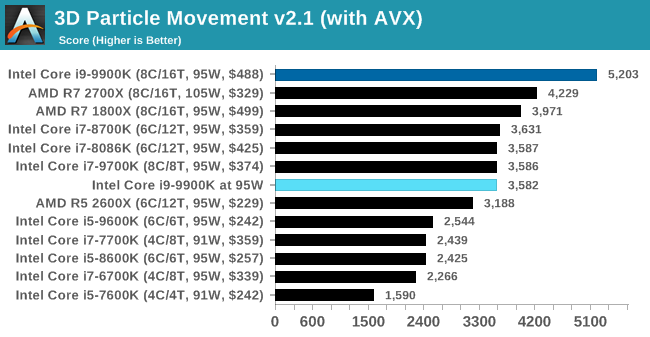
Dolphin 5.0: Console Emulation
One of the popular requested tests in our suite is to do with console emulation. Being able to pick up a game from an older system and run it as expected depends on the overhead of the emulator: it takes a significantly more powerful x86 system to be able to accurately emulate an older non-x86 console, especially if code for that console was made to abuse certain physical bugs in the hardware.
For our test, we use the popular Dolphin emulation software, and run a compute project through it to determine how close to a standard console system our processors can emulate. In this test, a Nintendo Wii would take around 1050 seconds.
The latest version of Dolphin can be downloaded from https://dolphin-emu.org/
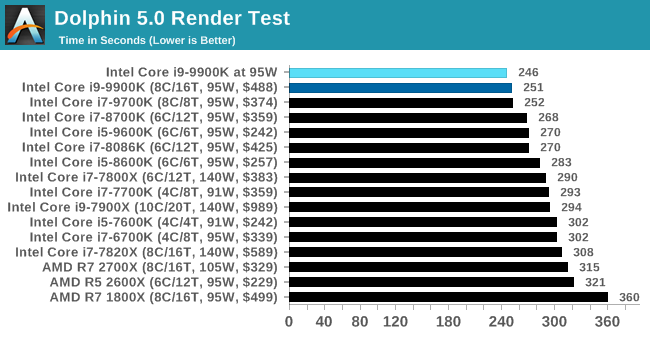
Dolphin is again a single threaded test, and the 9900K at 95W eeks out another small win.
DigiCortex 1.20: Sea Slug Brain Simulation
This benchmark was originally designed for simulation and visualization of neuron and synapse activity, as is commonly found in the brain. The software comes with a variety of benchmark modes, and we take the small benchmark which runs a 32k neuron / 1.8B synapse simulation, equivalent to a Sea Slug.
Example of a 2.1B neuron simulation
We report the results as the ability to simulate the data as a fraction of real-time, so anything above a ‘one’ is suitable for real-time work. Out of the two modes, a ‘non-firing’ mode which is DRAM heavy and a ‘firing’ mode which has CPU work, we choose the latter. Despite this, the benchmark is still affected by DRAM speed a fair amount.
DigiCortex can be downloaded from http://www.digicortex.net/
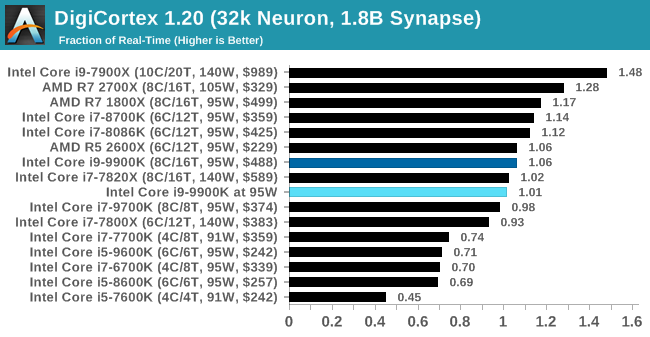
When it comes to a mixed benchmark like DigiCortex, the reduced power CPU actually performs around the same, given the same DRAM speed on both setups.
y-Cruncher v0.7.6: Microarchitecture Optimized Compute
I’ve known about y-Cruncher for a while, as a tool to help compute various mathematical constants, but it wasn’t until I began talking with its developer, Alex Yee, a researcher from NWU and now software optimization developer, that I realized that he has optimized the software like crazy to get the best performance. Naturally, any simulation that can take 20+ days can benefit from a 1% performance increase! Alex started y-cruncher as a high-school project, but it is now at a state where Alex is keeping it up to date to take advantage of the latest instruction sets before they are even made available in hardware.
For our test we run y-cruncher v0.7.6 through all the different optimized variants of the binary, single threaded and multi-threaded, including the AVX-512 optimized binaries. The test is to calculate 250m digits of Pi, and we use the single threaded and multi-threaded versions of this test.
Users can download y-cruncher from Alex’s website: http://www.numberworld.org/y-cruncher/
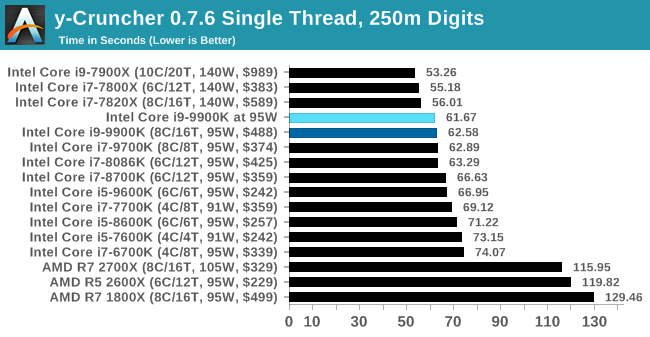
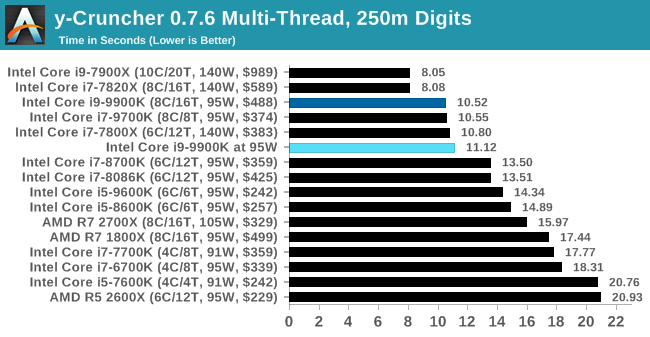
yCruncher shows another small win for the 9900K at 95W in single threaded mode, although this turns into a loss when all the threads are primed with AVX2 code.
Agisoft Photoscan 1.3.3: 2D Image to 3D Model Conversion
One of the ISVs that we have worked with for a number of years is Agisoft, who develop software called PhotoScan that transforms a number of 2D images into a 3D model. This is an important tool in model development and archiving, and relies on a number of single threaded and multi-threaded algorithms to go from one side of the computation to the other.
In our test, we take v1.3.3 of the software with a good sized data set of 84 x 18 megapixel photos and push it through a reasonably fast variant of the algorithms, but is still more stringent than our 2017 test. We report the total time to complete the process.
Agisoft’s Photoscan website can be found here: http://www.agisoft.com/
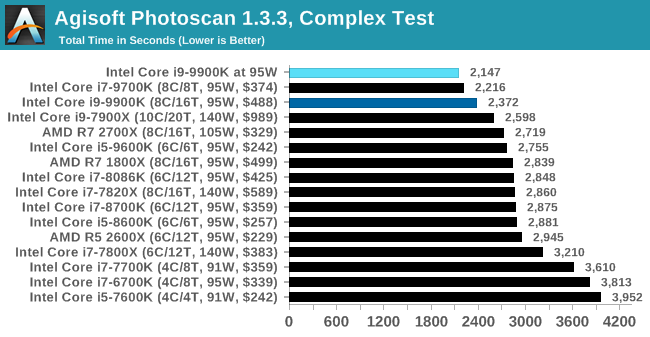
Photoscan is a mixed workload test, with certain portions being purely singe threaded and others being multithreaded. The 9900K at 95W wins by a good amount here.













101 Comments
View All Comments
DennisBaker - Tuesday, December 4, 2018 - link
I wanted to build a new PC on Black Friday, and I bought an i9-9900k. I never overclock and typically buy a locked/non-k CPU but couldn't wait until next year. I also always use a SFF case (Cooler Master Elite 130).This is a great article, but I'm not sure how to actually set the bios for a 95w max cpu setting.
I have the Asrock z390 phantom gaming-itx/ac motherboard:
http://asrock.pc.cdn.bitgravity.com/Manual/Z390%20...
I've been googling without success and figured I would just ask here if there is a general guide for this.
Targon - Thursday, November 29, 2018 - link
The real question is real world performance. If the goal is a SFF machine where you don't have closed loop coolers, and you have a small ITX motherboard and a small case, what will happen to temperatures in those cases. That is where you get heat related issues with performance.We know that the 2700X hits 4.3GHz, 4.4GHz in some situations, but put it in an ITX case, benchmark it. Will the i9-9900k end up being all that much faster when you are pushing your machine, not just in games, but when you are using your system as an 8 core system where you have web browsers, mail, MS Word, plus other things open at the same time? With all of this running, then go to it with your benchmarks. Compare how well the 2700 and 2700X perform without overclocking and just use the defaults to allow boost/turbo to operate. Is the 9900k all that much faster when playing games with that other stuff still running in the background? Push it for an hour of nonstop use to make sure that you are seeing how well the chip will work in the real world(when used by enthusiasts).
At that point, will we see the average CPU speed be 4GHz, or will it be down in the 3.6-3.7GHz range? Would the Ryzen chips at that point be faster in a SFF case than the i9-9900k?
HStewart - Thursday, November 29, 2018 - link
Another factor here is that it not CPU that uses the power, one must also include the power consumption of the GPU which is a lot of time significantly more power than the CPU.But in normal peoples usage in real world - the cores are not running as much. It requires that the software to be designed multithreaded or multiple applications running at the same time - the major problem is video is often have to single threaded. In the real world every one is not a hard core gamer.
One also remember that previous we had more desktop and all had external GPU's - but now with most of market - especially business market is mobile, the desired for high performance, high power system is not as important. So power savings modes is important to customers.
This is not just important for PC's - just this morning, I got message on my Samsung Note 8 that my settings was causing my phone to use battery
It really must be take in perspective of users needs - for hard core gamers - more cores, external GPUs are important. But for most users using Office and such, Internal GPU and dual core is fine.
BurntMyBacon - Thursday, November 29, 2018 - link
@HStewart: "It really must be take in perspective of users needs - for hard core gamers - more cores, external GPUs are important. But for most users using Office and such, Internal GPU and dual core is fine."Which group of users that you defined do you suppose is the target audience for the i9-9900K tested in this article?
HStewart - Thursday, November 29, 2018 - link
"Which group of users that you defined do you suppose is the target audience for the i9-9900K tested in this article?"Yes I realize that - but appears that people in this category tend to believe they are the only category. Also not all Hardcore Gamers are overclockers. I would say I done a lot of game in my life and even at 57 I still do. But all that time unless done by the manufacture, I have really not done it. I believe both my XPS 13 2in1 and XPS 15 2in1 have some built in over clocking but it is control by system.
All I am saying is everyone does not over clock and hard core games.
Targon - Thursday, November 29, 2018 - link
You don't need to manually overclock to enjoy the benefits of how long the processor can run at turbo speeds, vs. base speeds. If a chip can turbo to 5GHz all the time due to good cooling, then that will mean that even without manually overclocking, that CPU will have a much higher performance than lower tier chips. On the other hand, if the cooling isn't very good, then it will stay at base speeds most of the time.Small Form Factor....the beauty of having a small machine. If it also means that the performance will be limited due to cooling, then why bother paying for a faster processor when a slower processor will be almost as fast at half the price?
What many want to see are real world situations. People do not buy a 9900k if they don't want high performance, even if they do not manually overclock. So, 8 core/16 thread, because why pay for that if 4 core/8 thread, or 6 core/12 thread will perform just as well if not better? Same case size, will the 9900k be faster than a Ryzen 7 2700X in the same SFF case if the 9900k can't be cooled well enough to keep the chip running faster than base speeds? What would you do if the 2700X, which doesn't bench as well, were actually better at holding turbo/boost speeds in a SFF environment? Do you expect a SFF machine to have a discrete video card(which Intel chips don't necessarily need, even if the people who buy a 9900k will almost always put one in)?
Laptops are not the target of this article(no 9900k has ever been put into a laptop), so laptop boost/turbo results will be a bit more difficult because the design of the laptop itself won't allow a fair apples to apples comparison, unless you could swap the motherboards/processors while keeping the same motherboard/cooling.
HStewart - Thursday, November 29, 2018 - link
I understand laptops are not target of this article - but some crazy laptop makes like to put desktop components into perverted laptop.Like it not this industry is moving away from desktop components and not just laptops - all and ones are perfect example. The closet thing that Apple has to desktop is iMacMini. In ways even servers are changing - blades are good example.
As far as SFF concern mobile chips are idea for it - and a solution like EMiB is perfect for increase graphics performance - exceor the GPU in my Dell XPS 15 2in1 is just not inpar with NV|idia - Intel made a bad choice teaming up with AMD on it - don't get me wrong against iGPU - it is awesome and better than older generation NVidias like 860m
Manch - Friday, November 30, 2018 - link
And there it is. I was wondering how you were going to steer towards bashing AMD. LOLTheinsanegamerN - Thursday, November 29, 2018 - link
When you are not using the iGPU, it is powergated off. It isnt using any power, or if it is, it is minute to the point where it doesnt matter.People have been saying, for years, that the iGPU was a detriment to OCing and power usage. The existence of HDET has proven that idea wrong many, many, many times over.
Icehawk - Thursday, November 29, 2018 - link
How does HDET prove that an iGPU isn't a detriment to OCing or power usage? One might be able to argue that the dead silicon provides some sinking & surface area